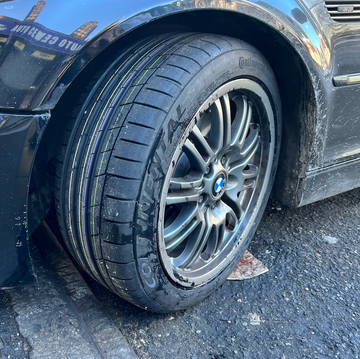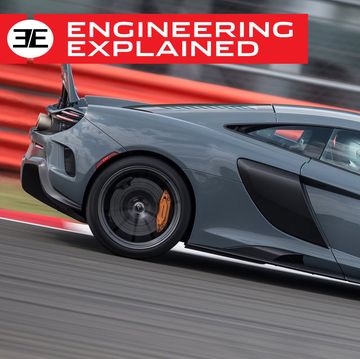When it comes to tires, Hankook may not be a household word...unless that household is home to a family of autocrossers who spend their free time crazily flinging cars around cones on abandoned airfields. Consider the most recent Tire Rack SCCA Solo Nationals in Lincoln, Nebraska, where the most popular street-tire class consisting of Honda S2000s, Mazda Miatas and the odd Toyota MR2 Spyder was running almost entirely on the Hankook Ventus R-S3. Thirteen of the top 17 trophy positions (64 entrants total) in Street Touring Roadster were on Hankooks in this hyper-competitive class, where the difference in time between 1st and 5th (the sum of a competitor's best runs on two separate, roughly 70-second courses) was 0.159 sec! Sneeze during one of these runs, and you'd drop five spots.
Video window may take a few moments to load...
But this Korean juggernaut has been quietly making inroads with mainstream passenger-car and light truck/SUV tires too (the Optimo and Dynapro lines, respectively) with more OE fitments by the day. The first big score was in 2004 when Hankook began supplying tires for the most American vehicle imaginable, the Ford F-150 pickup, the start of partnership with Ford that would grow to 3.5 million tires by 2006. Besides more obvious supply relationships with Kia and Hyundai, Hankook boasts the following clients: Chrysler, GM, Volkswagen, Navistar (a manufacturer of trucks and buses) and most recently, Mini, with the V-rated Ventus Prime² in a 195/55R-16 size for the Cooper S model.
100 Million Tires a Year by 2014
Currently the world's 7th-largest tiremaker, Hankook is growing rapidly, with plants under construction in Bekasi, Indonesia, and Chongqing, China, to augment existing plants in Korea (Daejon and Geumsan), China (Jiangsu and Jiaxing) and Racalmas, Hungary. This will take yearly production from roughly 89.5 million tires in 2011 to 100 million by end of 2014, in the process tying Pirelli for 5th largest. (By Hankook's reckoning, the four biggest manufacturers, in descending order, are Bridgestone Corp., Group Michelin, Goodyear and Continental AG.)
Hankook will accomplish this through a high level of automation, as we witnessed in a tour through the Geumsan plant, a 2-hour bus ride south of Seoul. Inside, one of the first things you notice is the eerie scarcity of humans. Laser-guided carts carrying rolls of rubber strips glide noiselessly toward preprogrammed destinations; there's the muted clatter of tires criss-crossing in chutes on ball-bearing rollers; and the whir of tires being spun up for dimensional accuracy checks. It's quite a contrast to the cacophony sometimes found in automobile final assembly plants. The workers oversee operation of the machinery, and a white-gloved technician hand-inspects each finished tire before applying a seal of approval, in the form of a bar-code decal on the tire's bead.
A Tire is Born
Although we weren't allowed to take close-ups of any particular process or machine (understandably, Hankook wants to keep its trade secrets close to the vest), we were given a good overall feel for how a tire comes to life. The initial step of mixing the rubber compounds, however, was completely out of view at a remote facility. Here, natural rubber, carbon black, silica, and a smattering of other secret ingredients are folded together in what's called a Banbury mixer, whose rotating elements are not unlike the vanes of a Roots-type supercharger.
Silica is wonderful stuff in that it can greatly reduce rolling resistance and improve wet and snow traction; the hard part is mixing it uniformly and getting it to adhere well to the compound's other components. And it's here that Hankook feels it has an advantage over its competitors.
Once the rubber is mixed, it's extruded into sheets of various thicknesses. Next comes a process called calendaring, where sheets of rubber are bonded to both sides of a sheet of belt material, whether it's steel, nylon, or other textile. Next, these calendared sheets are machine-cut to the required width, and the ends are cut to a specified angle. In a separate process, the tire's beads are pre-built, starting with hoops of brass-coated steel wire that are encased with an extruded filler.
It all comes together on a winding drum, where sheets that form the inner liner, internal plies and tread are stretched and wrapped around a cylinder, the sticky rubber acting as its own adhesive. The beads are slid on next (again, the machine operator oversees the process but never has to touch the tire), and then a quick burst of air inflates the assemblage into something that actually resembles a tire, albeit a puffy one you might see on an Alaskan Piper Super Cub. It's called a "green tire" at this stage.
In the final major step, the green tire is fed into a 2-piece mold that will give the finished tire its tread pattern and sidewall markings. Here, with a combination of heat and 120 metric tons of pressure, the tire undergoes the curing/vulcanization process. The heat (supplied by steam) and curing time varies with the type of tire. Truck tires? More of a crock-pot approach, with a cure time of 36–40 minutes at a temperature of 248 degrees F. Something like a Ventus R-S3? Just 12 minutes at a higher temperature, 280 degrees F. A more common passenger-car tire needs just 8–10 minutes.
After this, certain tires have their molding nubs shaved off, and down the line it's a series of computerized checks. Tires are given grades of A, B and C, with A-grade tires ready for shipping. B-grade tires can be reworked slightly to conform to A standards, while C-grade tires don't make the cut at all. A C-grade tire is a rare bird indeed....just 0.0001 percent of Hankook's tires achieve this infamy.
It's a fascinating process. There's a lot we take for granted when we jump into our cars and drive along on these amazing pneumatic donuts, whether it's a cruise to grandma's house or a violent slalom through a series of orange cones.






